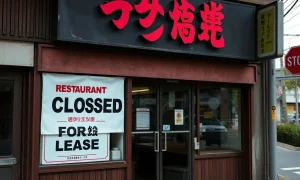The landscape of the fast-food industry is constantly evolving. However, recent news signals a significant shift. A prominent fast-food pasta chain faces widespread restaurant closures across its network. This development sends ripples through the market. For entrepreneurs and business owners, understanding these trends is crucial. It offers vital insights into the challenges and opportunities within the competitive food service sector. These closures highlight broader economic pressures and changing consumer behaviors.
Understanding the Scope of Restaurant Closures
Reports indicate that a well-known fast-food pasta chain is shutting down dozens of its locations. This move represents a substantial reduction in its operational footprint. Consequently, many communities will see a familiar eatery disappear. The decision reflects difficult choices faced by many businesses today. This specific chain, once a staple for quick and affordable pasta dishes, now confronts a challenging market. Its expansion strategy once seemed robust. Now, however, it must adapt to new realities.
Several factors contribute to such widespread restaurant closures. These issues are not unique to one brand. They often reflect systemic challenges impacting the entire restaurant sector. Businesses must navigate high operating costs and shifting consumer demands. Therefore, understanding these underlying causes is essential. It provides a clearer picture of the industry’s health.
- High Operational Costs: Rent, utilities, and ingredient prices continue to climb.
- Labor Shortages: Finding and retaining staff remains a significant hurdle for many.
- Intense Competition: The market is saturated with diverse dining options.
- Changing Consumer Habits: Delivery services and healthier eating trends alter demand.
Key Drivers Behind Widespread Restaurant Closures
Economic headwinds play a major role in the current wave of restaurant closures. Inflation has driven up the cost of everything. Food ingredients, packaging, and transportation are all more expensive. Businesses absorb some of these costs. Yet, they often pass others onto consumers. This can deter price-sensitive customers. Moreover, rising interest rates make borrowing money more costly. This impacts expansion plans and debt management for chains.
Furthermore, consumer behavior has undergone a significant transformation. People increasingly prioritize convenience. They also seek healthier options. The rise of food delivery platforms has changed dining habits. Many prefer to eat at home. This reduces foot traffic in traditional fast-food establishments. Also, dietary trends like plant-based eating influence menu choices. Chains that fail to adapt risk losing market share.
Operational inefficiencies also contribute significantly to financial distress. Managing a large network of restaurants is complex. Supply chain disruptions can impact food availability. They also affect pricing. Additionally, maintaining consistent service quality across many locations is difficult. Any lapse can damage brand reputation. Therefore, robust operational management is vital for survival. Without it, the risk of restaurant closures increases.
The Economic Impact of Restaurant Closures
The closure of dozens of restaurants has far-reaching economic consequences. Firstly, it results in job losses. Employees, from kitchen staff to management, face unemployment. This impacts local economies directly. Secondly, commercial real estate markets feel the effects. Vacant properties increase in number. This can depress property values. Landlords may struggle to find new tenants. Consequently, local tax revenues might decline.
Moreover, these restaurant closures signal a broader economic fragility. They can erode consumer confidence. When a popular chain struggles, it raises questions about the overall economic climate. Suppliers also suffer. Food distributors, equipment providers, and cleaning services lose business. This creates a ripple effect throughout the supply chain. Ultimately, the entire industry feels the pinch. It forces a re-evaluation of business models.
The situation also highlights the need for adaptability. Businesses must innovate to survive. Those resistant to change often face the steepest challenges. For instance, chains that embraced online ordering early fared better. Others struggled to catch up. Therefore, foresight and flexibility are key. They help mitigate the risk of widespread closures. The current climate demands strategic agility.
Adapting to Market Shifts: Lessons from Restaurant Closures
Successful restaurant chains are implementing various strategies to thrive. They understand the importance of innovation. Many are investing in technology. This includes advanced ordering systems and data analytics. Technology helps streamline operations. It also improves customer experience. For example, personalized marketing campaigns boost loyalty. These proactive measures help prevent restaurant closures.
Furthermore, menu innovation is critical. Consumers seek variety and new experiences. Restaurants are introducing diverse culinary options. They also cater to specific dietary needs. Healthier choices and sustainable sourcing appeal to modern diners. Cost control measures are also vital. Efficient inventory management reduces waste. Negotiating better deals with suppliers can cut expenses. These efforts protect profit margins.
Focusing on the customer experience remains paramount. Excellent service builds loyalty. Unique dining atmospheres attract patrons. Loyalty programs incentivize repeat visits. Building a strong community presence also helps. Engaging with local customers fosters goodwill. Ultimately, a strong customer base provides resilience. It acts as a buffer against economic downturns. This reduces the likelihood of future restaurant closures.
The Future Outlook for the Fast-Food Industry Amidst Restaurant Closures
The fast-food industry is undergoing a significant transformation. The current wave of restaurant closures might continue. However, it also presents opportunities for growth. Stronger, more adaptable businesses will emerge. Consolidation may occur. Smaller, independent eateries might find niches. They can offer unique concepts. Large chains will likely focus on efficiency and technological integration.
The emphasis will shift towards value and convenience. Automation in kitchens could increase. This addresses labor challenges. Drive-thru and delivery services will remain popular. Sustainability will also become more important. Consumers increasingly prefer environmentally conscious brands. Therefore, businesses must prioritize eco-friendly practices. This includes sourcing and waste reduction. The industry must evolve to meet these demands.
Ultimately, the sector will likely see more specialized offerings. Generic menus may become less appealing. Brands that connect authentically with their target audience will succeed. They will build strong communities. The lessons from recent restaurant closures are clear. Adaptability, innovation, and customer-centricity are not just buzzwords. They are essential for long-term viability in a dynamic market.
The recent news of a fast-food pasta chain’s extensive restaurant closures serves as a stark reminder. The restaurant industry faces unprecedented challenges. Economic pressures, evolving consumer preferences, and operational complexities demand constant vigilance. Businesses must proactively adapt. They need to innovate their offerings and streamline their operations. Only then can they navigate these turbulent times successfully. This ongoing evolution will shape the future of dining. It highlights the resilience required for success in a highly competitive market.
Frequently Asked Questions (FAQs)
Q1: Why are so many restaurants closing down?
A1: Many factors contribute to restaurant closures. These include rising operational costs like rent and ingredients, labor shortages, intense market competition, and shifts in consumer habits such as increased demand for delivery and healthier eating options. Economic downturns and inflation also play significant roles.
Q2: How do restaurant closures affect the economy?
A2: Restaurant closures have several economic impacts. They lead to job losses for employees, increase vacant commercial real estate, potentially decrease local tax revenues, and affect suppliers who lose business. This can also signal broader economic fragility and reduce consumer confidence.
Q3: What are fast-food chains doing to avoid closures?
A3: Fast-food chains are adapting by investing in technology for ordering and analytics, innovating their menus to include diverse and healthier options, implementing strict cost control measures, and enhancing the overall customer experience through loyalty programs and unique dining atmospheres.
Q4: Is the fast-food industry in decline?
A4: The fast-food industry is not necessarily in decline, but it is undergoing significant transformation. While some chains face closures, others are thriving by adapting to new market demands. The industry is evolving towards greater convenience, specialized offerings, and sustainability, requiring businesses to be more agile.
Q5: What should business owners learn from these restaurant closures?
A5: Business owners should learn the importance of adaptability, innovation, and customer-centricity. Proactive investment in technology, agile menu development, efficient cost management, and a strong focus on customer loyalty are crucial for navigating a dynamic and competitive market and avoiding similar restaurant closures.
























